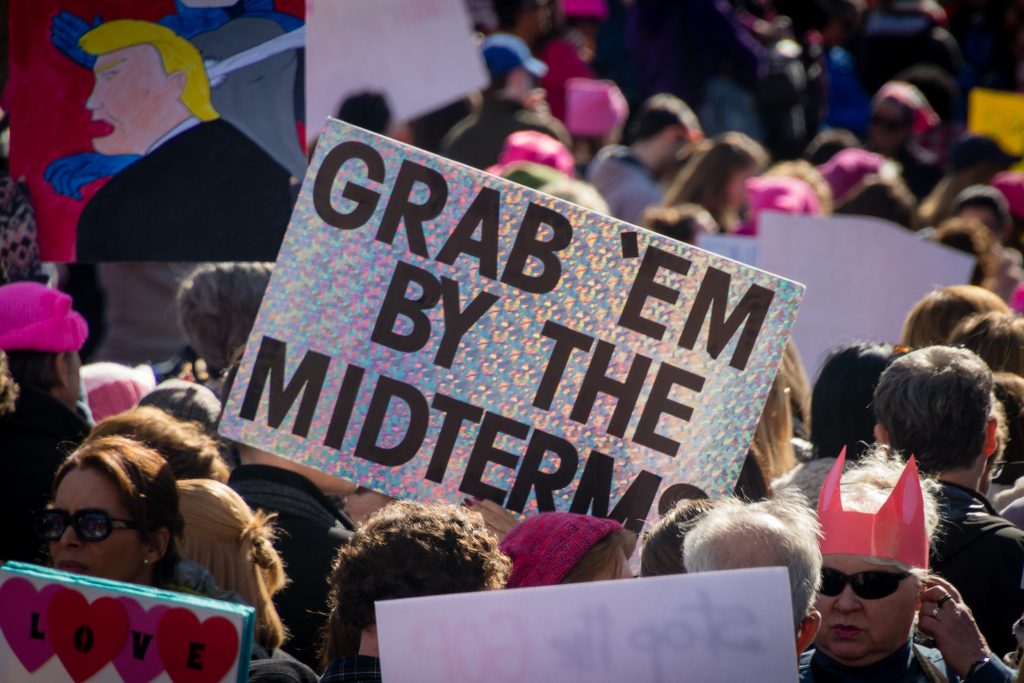
Signs across the country at Women’s Marches in January 2018 read “Grab ‘Em By The Midterms!” / Photo by John M., Creative Commons
The GOP leads on the economy while Democrats lead on health care and immigration.
Pew Research / 06.20.2018
The congressional elections are more than four months away, but voter engagement is high when compared with comparable points in previous midterm cycles. And a record share of registered voters (68%) say the issue of which party controls Congress will be a factor in their vote in November.

Compared with recent midterms, more voters also say their view of the president – positive or negative – will influence their vote for Congress. A 60% majority say they consider their midterm vote as essentially a vote either for Donald Trump (26%) or against him (34%). These are among the highest shares saying their view of the president would be a factor in their vote in any midterm in more than three decades.
In early voting intentions, 48% of registered voters say they would favor the Democratic candidate in their district, or lean toward the Democrat, while 43% favor the Republican or lean Republican.
The new survey by Pew Research Center, conducted June 5-12 among 2,002 adults, including 1,608 registered voters, finds that, unlike in recent midterms, voter engagement is high among members of both parties. Overall, 51% of registered voters say they are more enthusiastic about voting than usual, the largest share expressing increased enthusiasm about voting in a congressional election in at least 20 years.
A majority of voters who favor the Democratic candidate in their district (55%) say they are more enthusiastic about voting than usual, up sharply from 2010 and 2014. At about this point in 2006, when Democrats won majorities in both the House and Senate, somewhat fewer voters who backed the Democratic candidate (47%) said they were more enthusiastic about voting.
Yet enthusiasm among Republican voters is almost as high; 50% of voters who prefer the GOP candidate say they are more enthusiastic than usual, which is comparable to the level of Republican enthusiasm in 2014 (45%) and 2010 (55%). And in 2006, just 30% of voters who favored the Republican candidate indicated they were more enthusiastic about voting.
The survey finds that national political factors – views about partisan control of Congress and the president – are more important than in the past. Large majorities of voters who favor the Democratic (73%) and Republican (70%) candidates say the issue of which party controls Congress will be a factor in their vote. Again, the shares in both parties expressing this view are about as high as or higher than in recent midterm elections.

Trump is now a bigger negative factor in voting decisions for Democrats than Barack Obama was for Republicans during the midterm campaigns in 2010 and 2014. However, Trump also is much more of a positive factor for Republicans today than Obama was for Democrats in the previous two congressional elections.
About six-in-ten Democratic and Democratic-leaning registered voters (61%) say they think of their vote as a vote against Trump; in June 2006, a comparable share of Democrats (65%) considered their midterm vote to be a vote against George W. Bush. In both 2010 and 2014, smaller shares of Republican voters thought of their vote as a vote against Obama (54% in 2010, 51% in 2014).
Currently, 52% of Republican voters view their midterm vote as a vote for Trump, which is higher than the shares of Democrats who said this about Obama in 2010 (43%) and 2014 (35%), or the share of Republicans who saw their vote as being “for” Bush in 2006 (33%).
Here are some of the other major findings from the survey. (Also new today: Most Americans lack confidence in Trump to deal appropriately with Mueller probe.)
Trump job approval steady. In the survey, which was mostly conducted before Trump’s June 12 summit meeting with North Korean leader Kim Jong Un, 40% of adults say they approve of Trump’s job performance, little changed from earlier this year. Majorities say Trump has little or no respect for the nation’s democratic institutions and traditions (60% say this) and express little or no confidence in Trump to keep his business interests separate from presidential decisions (56%).

Majority has less trust in what Trump says compared with previous presidents.Overall, 54% say they trust what Trump says less than they trusted what previous presidents said when they were in office; just 25% say they trust Trump more than his predecessors, while 19% say they trust him about the same amount. About half of Republicans (52%) say they trust what Trump says more than previous presidents, compared with 5% of Democrats. Fewer Republicans express more trust in what Trump says than did so in April 2017 (66%); there has been little in change in Democrats’ views.
Trump widely viewed as lacking respect for many groups. Asked about Trump’s level of respect for various groups in society, majorities say he has little or no respect for several groups, including Muslims (68%), immigrants (64%) and women (56%); in addition, 67% say he has minimal respect for people who voted for Hillary Clinton. Trump is widely viewed as having a great deal or fair amount of respect for white people (82%) and men (76%).
What voters want candidates to discuss: immigration, health care. In an open-ended format, 19% of registered voters cite immigration as the issue they would most like candidates in their state or district to discuss, with 13% mentioning health care. While similar shares of Republican (21%) and Democratic voters (18%) say they would like candidates to address immigration, about twice as many Democrats (16%) as Republicans (8%) say the same about health care.

Democrats lead on several issues; GOP leads on economy. With the public’s views of the economy becoming more positive, the Republican Party holds a 45%-36% lead on dealing with the economy. Last October, the two parties were rated about even for handling the economy (38% Republican Party, 41% Democratic Party). The GOP once again has a significant lead on handling terrorism (43% to 32%); neither party had an advantage on terrorism in October.
On many other issues, however, the Democrats hold wide advantages. On both health care and immigration – two of the issues that voters mention most often as what they would like candidates to discuss – Democrats lead by 16 points and 14 points, respectively.

A wider gender gap among younger voters. Voting intentions for the midterm elections – and other political attitudes, including views of Trump – are deeply divided by education, age and gender.
A 54% majority of women voters say they support or lean toward the Democratic candidate in their district, while 38% favor the Republican. Among men voters, by contrast, 49% favor the Republican, while 43% support the Democrat. The gender divide is much wider among younger voters – those under 35 – than among voters 35 and older.
Women voters younger than 35 support the Democrat by an overwhelming margin (68% to 24%), while younger men are divided (47% favor the Democrat, 50% favor the Republican). The gender gap among voters ages 35 and older is more modest: 49% of older women favor the Democrat, as do 42% of older men.
1. Views of Donald Trump
The public’s views of Donald Trump across a number of dimensions – including his respect for democratic institutions, trust in what he says and whether he keeps his business interests separate from the decisions he makes as president – tend to have a fairly similar pattern.
On most measures (including his overall job rating), roughly 40% express positive views of Trump, while the rest of the public expresses negative or (depending on the question) neutral evaluations. And all attitudes about the president are deeply divided along partisan and ideological lines.
As has been the case since late in the 2016 presidential campaign, a majority (currently 60%) says that Trump has not too much (24%) or no respect at all (36%) for the nation’s democratic institutions and traditions. About four-in-ten (38%) say he has a great deal (18%) or a fair amount (20%) of respect for U.S. democratic institutions.

A sizable majority of Republicans and Republican-leaning independents (70%) say Trump has a great deal or fair amount of respect for democratic institutions and traditions, though fewer than half (38%) say he has a great deal of respect for these institutions. By comparison, just 13% of Democrats and Democratic leaners say Trump has at least a fair amount of respect for the country’s institutions and traditions. Nearly nine-in-ten Democrats (87%) say he has little or no respect for democratic institutions and traditions – with 59% saying he has no respect at all for them.
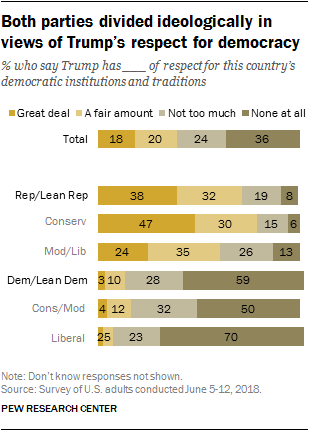
The share of Republicans who say Trump has at least a fair amount of respect for democratic institutions is 7 percentage points lower today (70%) than in March of this year or February 2017 (77% on both occasions).
Both parties are divided ideologically in views of Trump’s respect for democratic institutions: 47% of conservative Republicans say Trump has a “great deal” of respect for them, nearly double the share of moderate and liberal Republicans (24%). And liberal Democrats (70%) are 20 points more likely than conservative and moderate Democrats (50%) to say Trump has no respect at all for the nation’s democratic institutions and traditions.
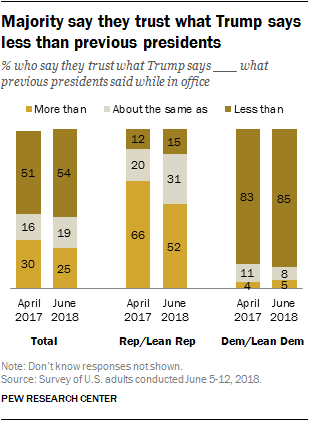
There also are sharp partisan differences when people are asked to compare their level of trust in what Trump says to what previous presidents said when they were in office.
Overall, about half of Americans (54%) say they trust what Trump says less than they trusted what previous presidents said while in office, a quarter say they trust what he says more, and 19% trust what he says about the same as they trusted what other presidents said.
These views have not changed a great deal since April of last year, though the share saying they trust what Trump says more than previous presidents has slipped from 30% to 25%, largely because of a decline among Republicans.
Today, 52% of Republicans say they trust what Trump says more than what previous presidents said, down from 66% last year. Democrats continue to overwhelmingly say they trust what Trump says less than past presidents.
Few are very confident Trump keeps business interests separate

About four-in-ten Americans (41%) say they are very (23%) or somewhat (18%) confident that Trump keeps his own business interests separate from the decisions he makes as president, while 56% are not too (15%) or not at all (42%) confident that Trump does this.
Roughly three-quarters of Republicans and Republican leaners (77%) express confidence in the president to keep his business interests separate from presidential decisions. Still, a wider majority of conservative Republicans (84%) say this than moderate and liberal Republicans (65%).
Fully 85% of Democrats and Democratic leaners say they are not too or not at all confident in Trump to do this, including 68% who say they are not confident at all.
Liberal Democrats are especially likely to say they have no confidence at all in Trump to keep his business interests separate: 77% say this, compared with 62% of conservative and moderate Democrats.
Republican views of Trump’s impact on the GOP
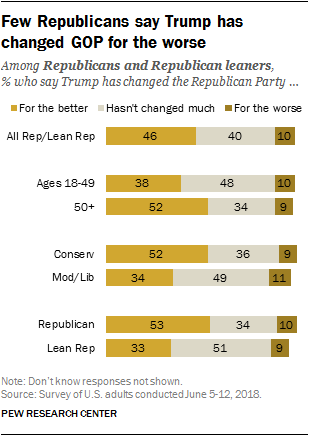
About as many Republicans and Republican leaners say Trump has changed the Republican Party for the better (46%) as say he hasn’t changed the GOP much (40%); just 10% think he has changed the party for the worse. These views are little changed from a year ago.
About half of conservative Republicans and leaners (52%) say Trump has changed the GOP for the better, 36% think he hasn’t changed the party much, and just 9% say he has changed the GOP for the worse.
Among moderate and liberal Republicans, a smaller share (34%) say Trump has changed the party for the better, while 49% say he hasn’t changed the party much (only 11% say he has changed the party for the worse).
Those who identify as Republican are more likely to view Trump’s impact on the party positively (53%) than to say he hasn’t changed the party much (34%). By contrast, the balance of opinion is reversed among independents who lean toward the Republican Party: 51% say he hasn’t changed the party much, while a third say he has changed the GOP for the better. Only about one-in-ten in either group say he has changed the party for the worse.
Widely varying views of Trump’s respect for different societal groups

The public gives sharply divergent assessments of Trump’s level of respect for differing gender, racial and ethnic, religious and other groups in society.
Majorities say Trump has a great deal or a fair amount of respect for men, white people, evangelical Christians and veterans.
Americans are less positive in evaluations of the level of respect Trump has for women, black people, Hispanic people, Muslims and immigrants. For each, more say he has little or no respect than say he has a great deal or fair amount of respect.
Moreover, nearly half say Trump has no respect “at all” for Muslims (47%) and immigrants (48%).
Overall, 46% say Trump has a great deal or fair amount of respect for “people like you.” Somewhat more (52%) say he has not too much or no respect at all for people like them.
And two-thirds of the public (67%) says that Trump has little or no respect for people who voted for Hillary Clinton – with 47% saying he has no respect at all for Clinton supporters.
Sizable partisan gaps in views of Trump’s respect for nearly all groups

There are large partisan divides in views of Trump’s respect for most demographic and other societal groups. Across the 11 groups asked about in the survey, large majorities of Republicans and Republican leaners say Trump has at least a fair amount of respect for nine.
About half of Republicans (53%) say Trump has a great deal or fair amount of respect for Muslims, while 45% say the same about his respect for people who voted for Clinton.
Democrats, by contrast, have overwhelming negative assessments of Trump’s respect for nine of the 11 groups. Just 8% say he has a great deal or a fair amount of respect for immigrants; 91% say he has not too much (16%) or no respect at all (75%) for immigrants.
Similarly, just 5% of Democrats say Trump has at least a fair amount of respect for Muslims. About nine-in-ten (92%) say he has little or no respect for Muslims, including 71% who say he has no respect at all for them.
However, there are two groups – white people and men – that majorities in both parties say that Trump respects. About nine-in-ten Republicans (92%) say Trump has at least a fair amount of respect for white people, as do 77% of Democrats. And majorities of Republicans (92%) and Democrats (68%) say Trump respects men.
Gender differences in views of Trump’s respect for men and women

Men and women generally think that Trump has a great deal or fair amount of respect for men. But they differ on how much respect he has for women.
Nearly half of men (47%) say Trump has a great deal or fair amount of respect for women, compared with 39% of women.
Gender differences in these views are much wider among younger adults than older people. Among those younger than 50, nearly half of men (48%) say Trump has a great deal or fair amount of respect for women, compared with 30% of women.
There are no significant differences in opinion among adults 50 and older: Roughly half of women (49%) and men (46%) say Trump has at least a fair amount of respect for women.
Majorities of Republican men and women say Trump has at least a fair amount of respect for women, though Republican men (83%) are more likely to say this than women (73%). Small shares of both Democratic men (14%) and women (16%) say Trump has a great deal or fair amount of respect for women.
Views of Trump’s respect for white, black and Hispanic people

In assessments of Trump’s respect for racial groups, there are wide differences by race and ethnicity.
Sizable majorities of whites (84%), blacks (77%) and Hispanics (78%) say that Trump has at least a fair amount of respect for white people.
By contrast, there are wider gaps in views of Trump’s respect for black and Hispanic people.
Among whites, 54% think Trump has at least a fair amount of respect for black people; fewer Hispanics (32%) say the same. Just two-in-ten blacks think Trump has at least a fair amount of respect for black people.
Similarly, about half of whites (48%) think Trump has respect for Hispanic people, compared with much smaller shares of blacks (21%) and Hispanics (20%).
Views of Trump’s respect for ‘people like you’

Nearly half of Americans (46%) say Trump has a great deal or fair amount of respect for people like them, while 52% think he has little or no respect.
These views, like opinions about Trump’s respect for various groups, differ widely by race, gender, age and partisanship.
A large majority of Republicans (82%) say Trump has a great deal or fair amount of respect for people like them. Among demographic groups, more than half of whites (55%) and men younger than 50 (54%) say Trump has at least a fair amount of respect for people like them.
By contrast, just 18% of Democrats, 18% of blacks, 31% of Hispanics and 40% of women say he has a great deal or fair amount of respect for people like them.
Younger women, in particular, have a negative view of Trump’s respect for people like them: Just 35% say Trump has at least a fair amount of respect for people like them – nearly 20 percentage points lower than 18- to 49-year-old men (54%). There are no significant differences in opinions among older men and women.
Among religious groups, 74% of white evangelical Protestants say Trump has a great deal or fair amount of respect for people like them, as do 54% of white mainline Protestants. Fewer than half of Catholics (44%) say Trump has at least a fair amount of respect for people like them; just 34% of those with no religious affiliation and 18% of black Protestants say the same.
Trump job approval little changed

Trump’s overall job approval has changed little over the course of this year. Currently, 40% approve of his job performance, while 54% disapprove. His approval rating was 39% in May, 39% in March and 37% in January.
The wide demographic differences in opinions about Trump – that have been evident since even before he took office – persist. While men are divided over Trump’s job performance (46% approve, 48% disapprove), women are far more likely to disapprove (60%) than approve (34%).
And Trump’s job approval is 12 percentage points lower among women younger than 50 (28%) than women 50 and older (40%). There is no gap in the views of younger and older men: 46% of both groups approve of the job he is doing.
Trump retains overwhelming support from Republicans and Republican leaners (79% approve), especially conservative Republicans (84%). Among Democrats and Democratic leaners, 86% disapprove of Trump’s job performance, including 93% of liberal Democrats.
2. The 2018 congressional election
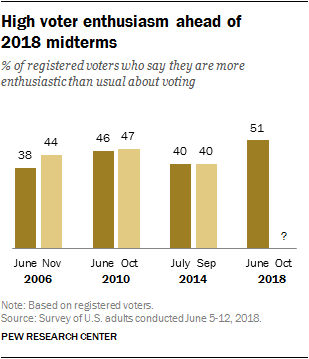
Less than five months before the 2018 midterm elections, about half of registered voters (51%) say they are more enthusiastic about voting compared with previous congressional elections. About a third (34%) say they are less enthusiastic than usual, while 13% volunteer that their enthusiasm is about the same as in the past.
The share of voters saying they are more enthusiastic than usual is at its highest level dating back to 2006. At about the same point in 2010, 46% of voters said they were more enthusiastic about voting than usual. In 2014 and 2006, 40% and 38%, respectively, expressed greater enthusiasm than usual about voting in congressional elections.
In the past, voters’ enthusiasm about voting did not change much between the summer and fall of midterm years. Today, a greater share of voters say they are more enthusiastic about voting than did so in the closing weeks of the three previous midterms.

Democrats hold a slight edge in voter enthusiasm: 55% of registered voters who plan to support the Democrat in their district say they are more enthusiastic about voting than usual, and 50% of registered voters who plan to back the Republican say the same.
The share of Democratic voters who say they are more enthusiastic than usual about voting is much higher than it was at about this point in 2014 (37%) or 2010 (42%).
Enthusiasm for voting among GOP voters is about on par with similar points during the 2010 (55% more enthusiastic) and 2014 (45%) midterms.
Among voters who support the Democratic candidate, liberals are especially enthusiastic: 64% say they are more enthusiastic about voting than usual, higher than in the four previous midterms. About half (48%) of moderate and conservative Democratic voters express greater enthusiasm, which is higher than in 2010 but about the same as the share saying this in other midterms since 2002.
Among voters who back the Republican candidate in their district, divides by ideology are more modest: 53% of conservatives say they are more enthusiastic than usual about voting, compared with 46% of moderates and liberals.
Similar shares in both parties are closely following campaign news

Overall, about six-in-ten registered voters (59%) say they are following news about elections and campaigns in their state and district very or somewhat closely. This is little changed from May, when 57% said they were following election news at least somewhat closely.
Republican voters are just as likely as Democratic voters to say they are following election news closely, but this masks ideological differences among these GOP voters. Two-thirds (67%) of conservative GOP voters say they follow news about elections and campaigns at least somewhat closely; only half of moderate and liberal Republican voters say the same. There is no ideology gap in attention among Democratic voters.
Older voters report following election news more closely than younger voters. About half of registered voters ages 18 to 29 (51%) say they are following election news very or somewhat closely; a similar share of voters ages 30 to 49 (54%) says the same. However, about two-thirds voters ages 50 to 64 (63%) and 65 and older (66%) say they are following the elections very or somewhat closely.
Control of Congress grows in importance as a voting issue
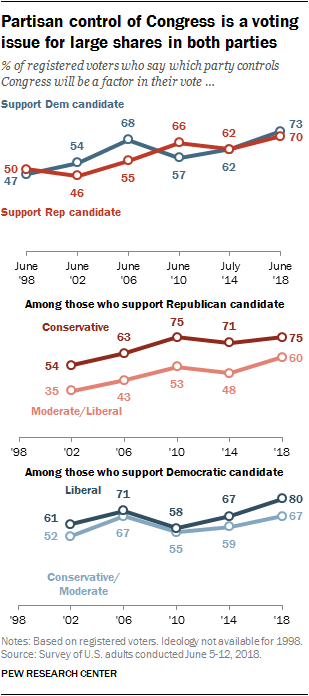
A large majority of registered voters (68%) say that which party controls Congress will be a factor in their vote this year. The share of voters who say partisan control of Congress matters for their vote is at the highest point in any midterm dating to 1998.
Comparable shares of registered voters who favor the Democratic candidate (73%) and the Republican candidate (70%) say the issue of which party controls Congress will be a factor in their vote. For both groups, the share who say they are thinking about party control in their midterm vote is as high as it has been in midterm elections dating to at least 1998.
While large majorities of voters backing both parties’ candidates say congressional control will matter for their vote this year, there are ideological differences within each party. Among those backing Democratic candidates, more liberals (80%) than moderates and conservatives (67%) say the issue of which party controls Congress is a factor in their vote. Similarly, among Republican candidate supporters, conservatives (75%) are more likely than moderates and liberals (60%) to say this.
Race, gender, age, education differences in midterm vote
At this stage of the midterm elections cycle, Democrats hold an edge in voting intentions. Nearly half of registered voters (48%) say, if the election were held today, they would support the Democratic candidate, or lean Democratic, while 43% plan to support the Republican Party’s candidate.
There are stark demographic differences in preferences on the generic ballot for Congress. By 54% to 38%, women say they plan to back the Democratic candidate in their district over the Republican candidate. By contrast, 49% of men plan to support the GOP candidate, compared with 43% who back the Democratic Party’s nominee.
The Democratic Party has wide advantages over the GOP among black (77%-16%) and Hispanic (63%-30%) voters. Whites express more support for the Republican: About half (51%) favor the Republican in their district, while 41% say they plan to support the Democrat.
Young adults ages 18 to 34 are more likely to say they plan to support the Democratic (57%) than Republican (37%) candidate in their district. Older voters are about evenly divided in their midterm preferences.
A majority of postgraduates (57%) and college graduates (56%) say they plan to vote for the Democratic candidate for Congress in their district. Voters with some college experience or no college experience are about as likely to say they will vote Republican as Democratic.

There also is a stark educational divide in preferences among white voters. By 53% to 41%, whites with a college degree favor the Democratic candidate in their district. By contrast, whites without a college degree back the Republican candidate 57% to 34%.
Young women stand out for their strong Democratic midterm preferences. Nearly seven-in-ten (68%) women ages 18 to 34 say they plan to support the Democratic candidate for Congress in their district; just 24% say they plan to back the Republican candidate.
The gender gap among older adults is more modest. For example, 45% of women ages 50 and older say they plan to support the Republican candidate in their district; roughly the same share of men 50 and older say the same (48%).
Most say Trump will be a factor in their congressional vote

Trump is a bigger factor in midterm voting preferences – positive or negative – than any president in more than three decades. About a third (34%) say they consider their vote for Congress as a vote against Donald Trump, while 26% consider their ballot as a vote for the president. Fewer than half (39%) say that Trump is not much of a factor in their vote.
At about this point in 2010, nearly half of voters (47%) said their view of Barack Obama would not be a factor in their vote; among those who said their view of Obama would matter, slightly more said they considered their vote as a vote against Obama (28%) than for him (23%).
And in 2014, 49% said their view of Obama would not be a factor; among the remainder, more considered their midterm vote as being against Obama (29%) than for him (19%).
Democrats broadly view their midterm vote as a vote against the president. Overall, 61% of Democratic and Democratic-leaning registered voters say they consider their vote for Congress to be a vote against Trump; a much smaller share (32%) says Trump is not much of a factor in their vote. Democratic opposition to Trump in their midterm vote is somewhat higher than Republican opposition to Obama eight years ago. In June 2010, 54% of Republicans said they considered their vote as a vote against Obama, while 41% said he was not a factor.
The share of Democrats who say they are voting “against” the president in the midterm is comparable to the share who said this in 2006, during George W. Bush’s second term. In June 2006, 65% of Democrats said they considered their midterm ballot as a vote against Bush.
Among Republican and Republican-leaning registered voters, 52% say they think of their vote for Congress as a vote for Trump, while 42% say he isn’t much of a factor. In the summer of 2010 and 2014, smaller shares of Democrats said their vote was for Obama (43% and 30%, respectively). And the share of Republicans who think of their midterm vote as a vote for Trump is much higher than in 2006, when just 33% of Republicans thought of their congressional vote as a vote for Bush.

Among Republicans and Republican leaners, nearly six-in-ten conservatives (58%) think of their congressional vote as a vote for Trump. Moderate and liberal Republicans are somewhat less likely to say this: 41% consider their midterm vote to be for Trump.

Among Democrats there is a more modest gap in views by ideology: Majorities of both liberals (65%) and conservatives and moderates (59%) say they consider their vote for Congress as a vote against Trump.
High anti-incumbent sentiment among voters
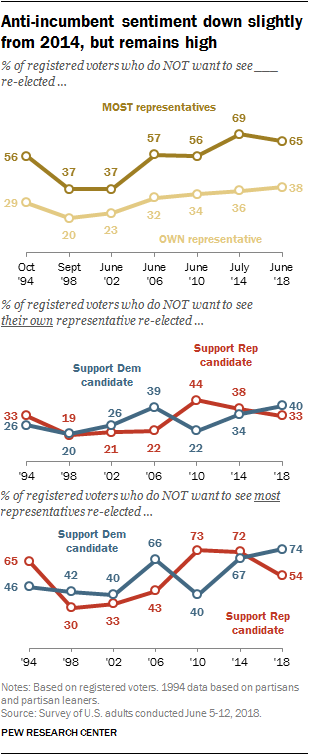
About two-thirds of registered voters (65%) say they do not want to see most members of Congress re-elected, which is down slightly from a similar point in 2014 (69% in July 2014) but higher than in 2010 (56%). As has been the case since 1994, fewer voters say they would not like to see their own representative re-elected (38%).
A larger share of Democratic voters (40%) than Republican voters (33%) say they would not like their own representative to be returned to Congress in this year’s elections. There was not a partisan gap in anti-incumbent feeling regarding their own representatives in 2014, but Republicans voters (44%) were far more anti-incumbent than Democrats (22%) in 2010. The 2006 cycle was the last time Democratic voters (39%) were more likely than Republican voters (22%) to not want to see their own representative re-elected.
For the first time since 2006, registered voters who plan to vote for the Democratic Party’s candidate in their district this fall (74%) are more likely than those who plan to vote Republican (54%) to say that they do not want to see most members of Congress re-elected. Anti-incumbent sentiment among Democratic voters is up from a similar point in 2014 (when 67% said this). The share of GOP voters saying this (54%) is down 18 percentage points compared with summer 2014 (72%).
Many voters want candidates to discuss immigration and health care

When asked about the issues they would most like to hear discussed in the congressional campaigns, voters were as likely to mention immigration issues as they were to want to hear about any other economic issue. About one-in-five (19%) mentioned immigration. Overall, 18% of voters mentioned some economic issue as what they wanted to hear discussed in the congressional campaigns.
Substantial shares of registered voters also wanted to hear about health care (13%), education (9%), guns and gun issues (8%), specific politicians or the government system (8%) and the economy (7%).
Overall, Republican and Republican-leaning voters’ answers were more varied to this question. The only thing that Republican voters mentioned at higher rates than Democratic voters was the border wall. Overall, 4% of Republican voters mentioned the border wall. Fewer than 1% of Democratic voters mentioned it.
Democrats and Democratic-leaning voters were at least twice as likely as Republicans to mention health care (16% vs. 8%), education (11% vs 4%) and racial issues (5% vs. less than 1%).
Majority says outcome of 2018 election is ‘very important’
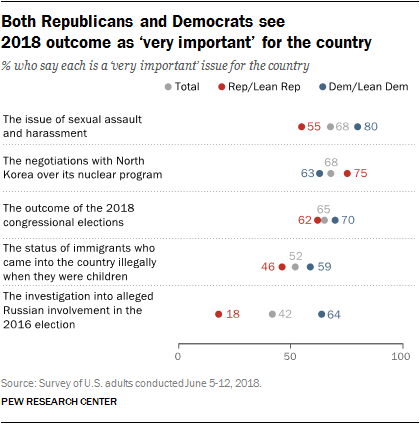
About two-thirds of Americans (65%) view the outcome of the 2018 congressional elections as a very important issue for the country. And while this view is widely shared in both parties, Democrats are somewhat more likely to say this than Republicans (70% vs. 62%).
There are wider partisan divides over the importance of some other issues, including the investigation into alleged Russian involvement in the 2016 election. Nearly two-thirds (64%) of Democrats and Democratic leaners say this investigation is “very important” for the country, but just 18% of Republicans and Republican leaners say the same (views on this issue are broadly similar to those measured in December 2017).
Democrats also are more likely than Republicans to view the issues of sexual assault and harassment (80% vs. 55%) and the status of immigrants who came to the country illegally when they were children (59% vs. 46%) as very important to the country.
By contrast, somewhat more Republicans (75%) than Democrats (63%) say the negotiations with North Korea over its nuclear program are very important. (Note: Most of the survey was fielded before the June 12 summit between Trump and North Korean leader Kim Jong Un.)
Voters have concerns about how 116th Congress – led by Republicans or Democrats – would deal with Trump administration
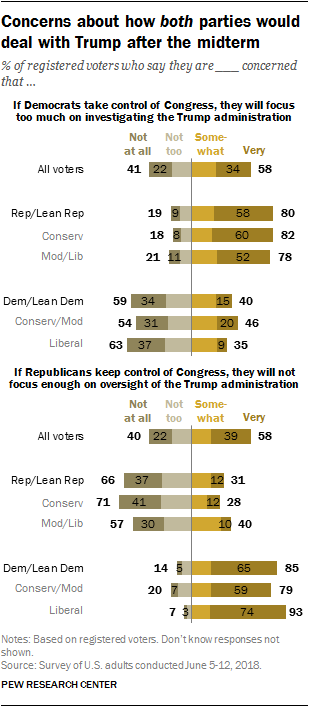
The majority of voters are concerned that – regardless of who is in control after this fall’s elections – Congress will not strike the right balance in its relationship with the Trump administration.
Nearly six-in-ten voters (58%) are very or somewhat concerned that if Democrats take control of Congress this fall they will focus too much on investigating the Trump administration.
An equal share (58%) is concerned that Republicans will not focus enough on oversight of the Trump administration if they keep control of Congress.
Partisans express great concern about how the other side would handle its relationship with the Trump administration, but they are less concerned about their own party’s approach.
A large majority of Republican and Republican-leaning registered voters (80%) say they are very or somewhat concerned that if Democrats win control of Congress, they will focus too much on investigating the administration. If the GOP retains control, far fewer Republicans say they are concerned the party will not provide enough oversight of Trump (though 31% say they are at least somewhat concerned about this).
Likewise, a large majority of Democrats and Democratic leaners (85%) are concerned that Republicans would not focus enough on oversight if they retain their majorities. Four-in-ten (40%) say they would be concerned about a Democratic-led Congress going too far investigating the Trump administration.
3. Views of the parties, Congress

The Democratic Party holds sizable advantages over the Republican Party on a number of major issues, ranging from the environment to foreign policy, as well as immigration and health care.
But the GOP now enjoys a 9-percentage-point advantage over the Democratic Party on the economy (45% to 36%) – a significant shift from October, when neither party held an edge on economic issues.
Though the public is currently split on which party could better handle tax policy, this is also a shift from October, when the Democratic Party was preferred by a 7-point margin.
The public also is divided on other economic policy areas such as the federal budget deficit and trade agreements.
Overall, the public favors the Democratic Party over the GOP on seven other major issues. The Democratic Party advantage is particularly wide on the environment (57% say the Democratic Party could do a better job, 25% say the Republican Party) and on dealing with issues involving race and ethnicity (52% to 28%). The Democratic Party also enjoys double-digit advantages as the party better able to deal with policies on abortion and contraception (50% to 31%), health care (48% to 32%), drug addiction (43% to 27%) and immigration (48% to 34%).
The current 9-point GOP edge on dealing with the economy is the first time a party has held a clear advantage on this issue since July 2014. Four years ago, 47% of the public said the Republican Party could better handle the economy, while 39% said the Democratic Party could better handle this issue. Today, the GOP enjoys a similar advantage (45% to 36%).
Since 2014, the Democratic Party has held a significant advantage over the GOP on health care issues. Today, it is favored by 16 points. Though little different from the Democratic Party’s advantage on this issue last year, this is among the widest advantages the party has held at any point over the past eight years.
For much of the Obama administration, neither party held a significant advantage in dealing with immigration issues. By early 2017, however, the Democratic Party opened up an 11-point advantage over the GOP. Today, the Party holds a similar 14-point edge on this issue.
The Democratic Party holds an 8-point advantage as the party seen as better able to make wise decisions about U.S. foreign policy (44% to 36%). The Democrats have had a similar-sized edge on this issue since April 2017. This is a shift from years prior, when public preferences were split or the GOP had an edge.

By contrast, the Republican Party is viewed by a larger share of the public as better able to deal with terrorist threats at home (43% say this, while 32% say the Democratic Party). While this is a shift since October, when the public was divided about their preferences, the current 11-point GOP edge is on par with past years.
As has been the case since 2017, views of which party could better handle trade agreements are split: 41% say the Republican Party, 40% the Democratic Party. In April 2016, the GOP had a double-digit advantage (48% to 37%) on this issue.

When it comes to dealing with policies on abortion and contraception, the Democratic Party continues to be preferred over the GOP by a wide margin (50% to 31%). And the preference for the Democratic Party on the environment is even wider: By a 32-point margin (57% to 25%), the public prefers the Democrats on environmental issues.
The Democratic Party now holds a narrow edge on gun policy: 44% say the Democratic Party could do a better job reflecting their views on this issue, compared with 38% who say the Republican Party could do a better job. The share of the public who says the Republican Party would be better at reflecting its views about gun policy has declined 8 points since April 2017.

Views of congressional productivity
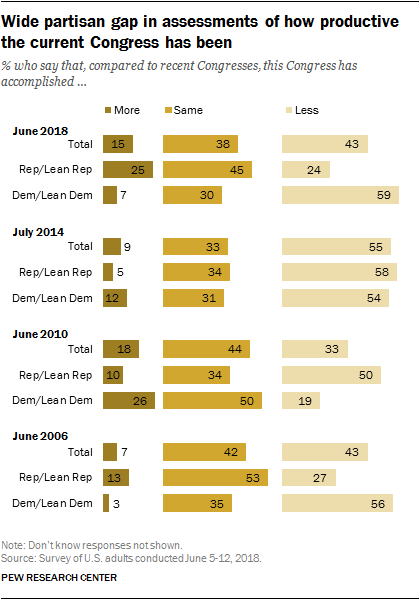
Currently, 43% of the public says that the 115th Congress has accomplished less than other recent Congresses; 38% say this Congress has accomplished about the same amount. Only 15% say this Congress has been more productive than others. The share of the public viewing Congress as productive is higher today than it was last winter (15% now, 8% then), while the share saying it has been less productive has dropped from 52% to 43%.
There are wide partisan gaps in views of congressional productivity. Only about a quarter of Republicans and Republican leaners (24%) say that the current, GOP-controlled, Congress is less productive than others. A plurality (45%) says it has accomplished about as much; a quarter say it is more productive than others.
In contrast, about six-in-ten Democrats and Democratic leaners (59%) say this Congress has been less productive compared to recent Congresses, while 30% say it has been about as productive and just 7% say it has been more productive.
This pattern is consistent with past years. In both 2006 and 2010, partisans of the party in control of Congress and the presidency offered far more positive assessments of congressional productivity than did those in the other party.
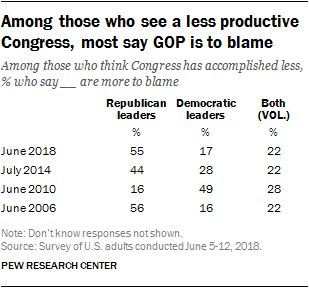
Among those who say that this Congress has accomplished less (68% of whom identify as Democrats or lean Democrat), a majority (55%) says Republican leaders are most to blame for this. Roughly a quarter (22%) say both parties’ leaders are to blame and 17% say Democratic leaders are to blame.
Among Republicans who say that the current Congress has accomplished less, 55% say Democratic leaders are to blame, while 27% say both parties’ leaders are to blame. Another 15% say their own party’s leaders are to blame.
In contrast, nearly three-quarters (73%) of Democrats who think this Congress has accomplished less say that Republican leaders are to blame. About two-in-ten (18%) say both parties’ leaders are at fault. Just 5% place the blame primarily on the Democratic leadership.
Low job approval for both parties’ congressional leaders
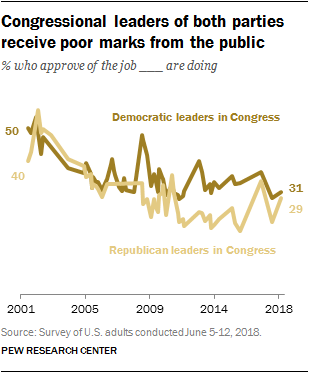
On balance, the public disapproves of the job congressional leaders of both parties are doing. Overall, about three-in-ten say they approve of the job Democratic leaders are doing (31%), while a very similar share say they approve of the job Republican leaders in Congress are doing (29%).
Approval for Democratic leaders in Congress is little changed since October and remains lower than public views of the Democratic leadership in February 2017.
In contrast, approval ratings for Republican leaders have improved since October (from 22% in October to 29% today).

The recent improvement in Republican leaders’ approval ratings is attributable to warmer ratings from within their own party. In October, just 39% of Republicans and Republican leaners said they approved of their party’s leadership in Congress. Today, Republicans are more approving than disapproving: Just over half (52%) say they approve and four-in-ten say they disapprove.
Republicans’ ratings of their own party’s leadership have oscillated significantly over the past two decades, from a high of 83% in 2003 to just 26% in 2015.
On the other side of the aisle, Democrats’ views of their party’s congressional leadership are divided (47% approve, 43% disapprove). This is mostly unchanged since October and significantly lower than Democratic assessments of Democratic leaders in the five years prior.
Both Republicans and Democrats give poor ratings to congressional leaders of the opposing party. Today, only about one-in-ten give the other party’s leaders satisfactory marks.
More see immigration as most important national problem
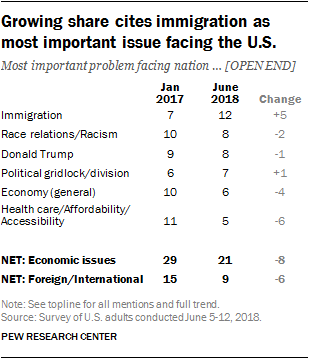
When asked in an open-ended format about the most important problem facing the country today, a growing share of the public cites immigration as its top concern. Overall, 12% volunteer immigration as the country’s most important problem, the most-cited issue in the survey. Mentions of immigration are up from January 2017, when 7% said this was the country’s top problem.
Race relations and racism (8%), and mentions of Donald Trump (8%), also rank near the top of the public’s most important problem list. Public views of the importance of these two issues are similar to the days immediately preceding Trump’s inauguration.
The shares who cite the economy or unemployment as the country’s top problems are both down from the start of 2017. In addition, fewer cite health care as the nation’s biggest problem today than did so in January 2017.
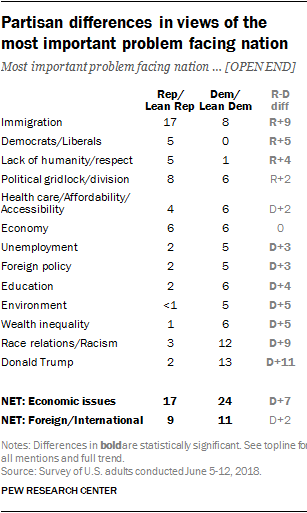
There are significant differences between how Republicans and Democrats view the most important problems facing the nation.
Immigration is far and away the top problem cited by Republicans and Republican leaners: 17% say this, compared with fewer than 10% who cite any other issue.
Political gridlock and division is the second most-mentioned issue for Republicans: 8% volunteer that this is the most important problem facing the nation. Another 5% say Democrats or liberals are the country’s biggest problem.
Among Democrats and Democratic leaners, Donald Trump (13%) and race relations and racism (12%) are cited most frequently as the nation’s top problem; 8% of Democrats say immigration is the country’s most important problem.
Originally published by Pew Research Center, reprinted with permission for non-commercial, educational purposes.

